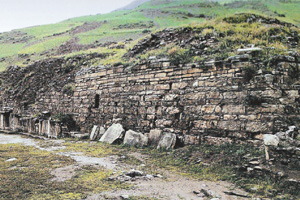Before the Incas (or Inkas, a culture which will be examined in a future issue) expanded their empire across the area sheltered by the Andes Mountains, many nations had developed in the central region of the Andean massif, especially in the coastal and high plateau areas. Therefore, from approximately the year 1000 B.C. until halfway through the 16th century A.D., the Chavín, Paracas, Vicus, Recuay, Moche, Nazca, Tiwanaku, Wari, Mayta-Chiribaya, Sicán Lambayeque, Chimú, and Chancay cultures arose.
The majority of these cultures developed highly complex agricultural practices, as they were able to cultivate a great variety of plants, even more than in Europe, despite having neither ploughs nor wheels. Likewise, they stood out for their excellent gold and silverwork and for the construction of pyramids and ceremonial centres.
Many of these nations were no longer in existence or were in decline when the Spanish conquerors arrived. However, some of their former splendour can still be appreciated today.
Where were they?
The following paragraphs indicate the areas where these cultures settled, together with a brief statistical outline of these regions or countries.
The Chavín and Recuay cultures mainly settled in the department of Ancash, which is located in northern Peru. It has a population of around one million inhabitants and an area of approximately 30,000 km2. It stretches from the sierra to the coast and its climate is varied: near the sea it is warm, and, depending on the different areas of the sierra, it can be temperate-dry, cool-dry, and warm-humid. Its capital is Huaraz.
Chavín also reached as far as southern Ecuador, a country with Quito as its capital city and a population of almost 14 million people, spread over an area of 283,520 km2. It is bounded to the north by Colombia, to the south and east by Peru and to the west by the Pacific Ocean.
The geographical centre of the Paracas and the Nazca cultures was in the current department of Ica, whose capital is the city of the same name. It has around 600,000 inhabitants and an area of 21,305 km2. It is located in southern Peru and is made up of mostly coastal territory. The climate is warm and dry.
The Vicús culture developed in the department of Piura, which has an area of 35,891 km2 and a population of around one million 500 thousand. It is located on the northern coast of Peru and its capital is the city of Piura. The climate is warm throughout the year.
Peru and Bolivia
The Moches (or Mochicas) were primarily located in the departments of Lambayeque and La Libertad, on the northern coast of Peru. In Lambayeque (where the Sican Lambayeque nation was also established) there are slightly over one million people, in an area of 14,231 km2. Its capital is Chiclayo and the predominating climate is subtropical and dry-tropical.
La Libertad, where the Chimu culture was also situated, spreads over almost 25,500km2 and has a population of 500 thousand inhabitants. The city of Trujillo is its capital, and its climate alternates between warm and sunny on the coast, and dry and temperate in the Andean area.
Around Lake Titicaca, which is shared by Peru and Bolivia, the Tiwanaku culture developed. The capital of Bolivia is Sucre and the seat of government is La Paz. Bolivia has a population of around 9 million inhabitants living in an area of 1.098.581 km2. It is bounded to the north and east by Brazil, to the south by Paraguay and Argentina, and to the west by Chile and Peru.
The Wari culture blossomed in the department of Ayacucho, which is located on the sierras near the centre of Peru. The population is about half a million people. Its area is 48,814km2 and its capital is Ayacucho. The climate is characterised by being temperate and dry.
Mayta-Chiribaya
This culture settled in an area which currently belongs to the Peruvian Department of Moquegua, which has an area of around 15,000km2 and a population of almost 138,000 people. Its capital is the city of Moquegua. This department is located on the southern coast of Peru and its climate changes according to altitude. Therefore, on the coastal fringe it is warm and humid, but as the altitude increases, conditions vary from temperate, to cold temperate, and glacial.
Finally, the Chancay culture took over the territory which now forms part of the department of Lima. This is found on the central coast of Peru and is inhabited by a little more than 8 million people, occupying an area of 34.797 km2. Its capital is the city of Lima, and the climate is mild and cool.








